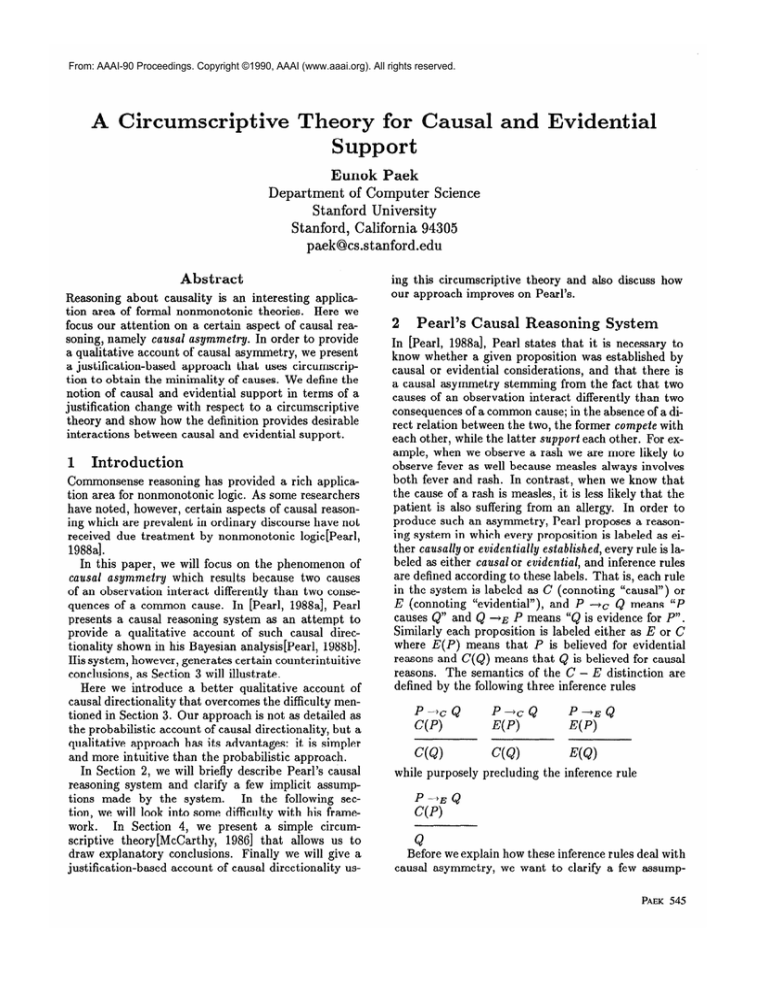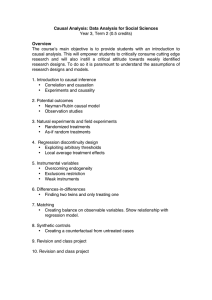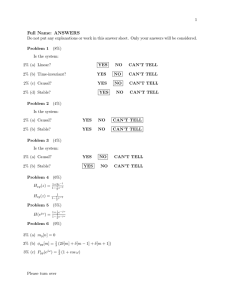
From: AAAI-90 Proceedings. Copyright ©1990, AAAI (www.aaai.org). All rights reserved.
A Circumscriptive
Theory for Causal and Evidential
Support
Eunok Paek
Department of Computer Science
Stanford University
Stanford, California 94305
paek@cs.stanford.edu
Abstract
Reasoning about causality is an interesting application area of formal nonmonotonic theories. Here we
focus our attention on a certain aspect of causal reasoning, namely causaZ asymmetry. In order to provide
a qualitative account of causal asymmetry, we present
a justification-based approach that uses circurnscription to obtain the minimality of causes. We define the
notion of causal and evidential support in terms of a
justification change with respect to a circumscriptive
theory and show how the definition provides desirable
interactions between causal and evidential support.
1
Introduction
Commonsense reasoning has provided a rich application area for nonmonotonic logic. As some researchers
have noted, however, certain aspects of causal reasoning which are prevalent in ordinary discourse have not
received due treatment by nonmonotonic logic[Pearl,
19SSa].
In this paper, we will focus on the phenomenon of
causal asymmetry
which results because two causes
of an observation interact differently than two consequences of a common cause. In [Pearl, 19SSa], Pearl
presents a causal reasoning system as an attempt to
provide a qualitative account of such causal directionality shown in his Bayesian analysis[Pearl, 1988b].
His system, however, generates certain counterintuitive
conclusions, as Section 3 will illustrate.
Here we introduce a better qualitative account of
causal directionality that overcomes the difficulty mentioned in Section 3. Our approach is not as detailed as
the probabilistic account of causal directionality, but a
qualitative approach has its advantages: it is simpler
and more intuitive than the probabilistic approach.
In Section 2, we will briefly describe Pearl’s causal
reasoning system and clarify a few implicit assumptions made by the system.
In the following section, we will look into some difficulty with his frameIn Section 4, we present a simple circumwork.
scriptive theory[McCarthy,
19861 that allows us to
draw explanatory conclusions. Finally we will give a
justification-based account of causal directionality us-
ing this circumscriptive theory and also discuss how
our approach improves on Pearl’s.
2
I?earl’s Causal
Reasoning
System
In [Pearl, 1988a], Pearl states that it is necessary to
know whether a given proposition was established by
causal or evidential considerations, and that there is
a causal asymmetry stemming from the fact that two
causes of an observation interact differently than two
consequences of a common cause; in the absence of a direct relation between the two, the former compete with
each other, while the latter support each other. For example, when we observe a rash we are more likely to
observe fever as well because measles always involves
both fever and rash. In contrast, when we know that
the cause of a rash is measles, it is less likely that the
patient is also suffering from an allergy. In order to
produce such an asymmetry, Pearl proposes a reasoning system in which every proposition is labeled as either cuusalty or evidentially established, every rule is labeled as either cuusuZor evidential, and inference rules
are defined according to these labels. That is, each rule
in the system is labeled as C (connoting “causal”) or
E (connoting “evidential”), and P -)c Q means “P
causes Q” and Q +E P means “Q is evidence for P”.
Similarly each proposition is labeled either as E or C
where E(P) means that P is believed for evidential
reasons and C(Q) means that Q is believed for causal
reasons. The semantics of the C - E distinction are
defined by the following three inference rules
P--e&
P--v&
P-E&
C(P)
E(P)
E(P)
C(Q)
C(Q)
E(Q)
while purposely precluding the inference rule
P-+E&
cm
Q
Before we explain how these inference rules deal with
causal asymmetry, we want to clarify a few assumpPAEK
545
tions made by Pearl’s reasoning system. First, in his
reasoning system it is not specified how we initially
obtain propositional labels. When we have some labels for certain propositions initially, we can deduce
other labeled propositions by using the initially labeled
propositions and rules according to the inference rules
sanctioned by the system. Without any initial labeling,
however, we cannot use the inference rules at all. But
from the fact that we can use a causal rule P -)c Q together with a proposition P regardless of its label, we
can obtain labels for certain propositions without any
initial labeling for P. From now on, whenever we have
a rule P -+c Q and a proposition P without any label,
we will assume that C(Q) follows. Secondly, there is an
implicit correspondence between causal and evidential
rules. That is, the database must have Q -fE P whenever it has P -)c Q. If we can represent evidential
rules without assuming the existence of their causal
counterparts, some inference rules can be counterintuitive. If there is a strong correlation between two events
without any causal connection, sometimes we should
allow the inference prohibited by Pearl’s reasoning system. For example, suppose that the database has the
+E BrownHair
tosentence ‘v’x.Take,cs22l(x)
gether with C(Take,cs221(
John)); we can easily imagine a situation in which John is taking cs221 to fulfill
his course requirements, hence Take As221 (John) is
“causally established.” It is apparent that we should
conclude BrownHair(
John). We can justify the reasoning system presented above only when we assume
the coexistence of both causal and evidential rules.
With these assumptions in mind, let us look at
the following example, which is slightly modified from
[Pearl, 1988a].
Example
1
Suppose we have the knowledge about causation that
rain causes grass to be wet, that a sprinkler also causes
wet grass and that rain causes slippery roads. Its translation into Pearl’s representation will be as follows:
Rain +C WetGrass;
Sprinkler -+c WetGrass;
Rain +C SlipperyRoad;
Wet Grass +E Rain;
WetGrass
+E Sprinkler;
SbipperyRoad
-fE Rain.
If we came to know WetGrass
because of Rain,
WetGrass
would be labeled C according to the assumption mentioned above. When WetGrass
is labeled C, it cannot be used to infer Sprinkler
together
with the evidential rule WetGrass
-)E Sprinkler,
because it is not sanctioned by the system. This shows
how two causes of a single effect work against each
other. On the other hand, if SlipperyRoad
were labeled E, we would deduce E(Rain) using the evidential rule SlipperyRoad
-)E Rain, and C(WetGrass)
546
KNOWLEDGEREPRESENTATION
would follow from E(Rain) and Rain +C WetGrass.
In this case, two consequences of a single cause work
for each other.
3
Difficulty
with Pearl’s
System
With the assumptions mentioned in the previous section in mind, we will now see what can go wrong
with Pearl’s reasoning system. For instance, when
WetGrass
is established evidentially, it can be used to
infer both Rain and Sprinkler,
which is rather counterintuitive. Instead, what we would like to conclude
from WetGrass
is Rain or Sprinkler.
One way to overcome this counterintuitive result is
to weaken the meaning of the labels (C and E) from
that of acceptance to that of support. That is, we reinterpret the meaning of E(Sprinkder)
as there is evidential support for Sprinkler,
not as Sprinkler
holds
for an evidential reason. Once we reinterpret the E label as support, concluding E(Rain) and E(Sprinkler)
from WetGrass
is no longer counterintuitive. We have
reason to believe that it might have rained, and also
that the sprinkler might have been on.
Once we weaken the meaning of the E label from acceptance to support, we must also weaken the meaning
of the C label. Since one of the three inference rules
allows us to infer C(Q) from E(P) and P -+c Q and
E(P) means only that P is evidentially supported, we
are no longer justified in saying that Q holds for a
causal reason. Instead, we can say that Q is cuusuNy
supported.
Having a notion of support and making a distinction
between causal and evidential support may be useful.
However, we still need a mechanism to draw conclusions. If we know it rains, it is clear that we should
conclude that the grass is wet, in addition to concluding that there is causal support for the wet grass. In
the following sections, we will show how a simple circumscriptive theory can be used to draw conclusions
and then see how we can use this circumscriptive theory to define the notion of support.
4
Circumscription
Causes
for Minimization
of
In this section, we propose a simple circurnscriptive
theory which allows us to draw explanatory conclusions
by minimizing causes.
In order to minimize causes, we will reify causal information by using the predicate causes(P, Q). The
intended meaning of causes(P, Q) is that P causes
Q to hold. We will also use the predicates holds(P)
and holds,acausadly(
Q) , meaning that P is true and
that Q is true without any cause being known, respectively. Let the causal theory be divided into two parts,
7 =< R,F >. R consists of instances of the causes
predicate together with the following axiom:
Vx.holds(x) [jy.causes( y, x) A holds( y)] V holds,acausally(x)
(1)
F consists of instances of the holds predicate’.
Given a two-part background theory < R, F >,
we will circumscribe it by minimizing causes and
holds&causally
with causes given higher priority.
causes is given higher priority because we would like
to say that something holds acausally only when we
cannot find a cause for it from all we know. That is,
we are justified in saying that an event holds acausally
only when we do not have any information about its
cause.
cation change and compare our notion of support with
the propositional labels in Pearl’s C - E system.
5.1
Justification
Informally, a justification for a certain proposition is a
reason to believe that proposition. Let 7 be our background theory. We will define Jr to be a mapping
from a well-formed formula to a well-formed formula.
If Jo
= /?, then Q will be true whenever p (a justification for (w) is true in the models of the theory 7.
That is, 7 U (p} b LY.A formal definition for a justification follows.
Definition
Example
2
Let our background theory be as follows:
R : (causes(Rain,
WetGrass),
causes(Rain,
SlipperyRoad),
causes(Sprinkler,
WetGrass))
F : (holds(WetGrass))
with Axiom (1)
If we circumscribe
the background theory in
we can conclude
holds(Rain)
V
this example,
Consider all the minimal models
hoZds( Sprinkler).
that satisfy the result of circumscription. In all minBy the aximal models, nothing holds acausally.
iom (l), we know that hoZds(WetGrass)
is true if
and only if any of its causes holds. In this example, the only causes for WetGrass
are Rain and
Sprinkler.
Hence holds(Rain)
V holds(Sprinkler)
is
true in all minimal models. However, we will not have
holdstRain)
/\ holds(SprinkIer).
Using the circumscribed background theory, we will
define the notion of support in the following section.
5
Supports
As we saw in the previous section, circumscription allows us to draw explanatory conclusions without any
unintuitive behavior, and that without the burden
of specifying propositional labels initially. However,
the notion of causal/evidential support may be useful
for certain problems. For instance, we may want to
know how one event causally/evidentially
affects another even if this event does not logically follow from
the other.
As a logical abstraction of probabilistic analysis, we
will use a justification-bused
notion of support. First,
we will define what a justification is. Then we will
define causal and evidential support in terms of justifi‘How to axiomatize causality is an important problem
in and of itself, but it is not what we are interested in.
We are interested in how to obtain the proper interaction
between causal and evidential support. We believe that the
results in the following sections apply independently of the
axiomatization used for a causal theory.
5.1.1 (Justification):
Given a set of first-order sentences ‘7 and a well-formed
formula (Y, JI(CV) = /3 if and only if
for each /3j such that
(1) 7 U {@j} is satisfiable;
(2) 7 U {Pj) I= a; and
is a conjunction of literals.
(3)
pi
Our definition of justification is closely connected
with the definition of minimal support in the Clause
Maintenance System (CMS) by Reiter and deKleer
[Reiter and de Kleer, 19871. They define support as a
set of literals which satisfies the conditions (1) and (2)
in Definition 5.1 .l, and minimal support as a minimal
such set. Here we obtain minimality of justification by
taking a disjunction of all &‘s rather than requiring
each ,L$to be minimal. That is, we would like to think
of justification as a well-formed formula in disjunctive
normal form. Viewing justification as a formula allows
us to handle disjunctive explanation easily, thus giving
us much more flexibility in defining support.
The third condition deserves some attention. Let
us see what happens if we don’t have this condition.
Given an empty background theory, the justification
for P will be P itself. That is, it can only be selfjustified because we do not know anything about P.
Once we add Q, which may have nothing to do with
P, justification for P will change to 1Q V P. This
is equivalent to Q > P. This is undesirable because
Q can be a random proposition which may have no
relevance to P. If we don’t have the condition (3),
T Z) o will be a valid /3i for justification of cy for any r
in 7.
The addition of condition (3) creates another interesting effect. Suppose our initial background theory
was R z (1Q v P), i.e., we explicitly name Q > P as
R. Now JT(P) = R A Q. Simply giving a name for
Q > P causes it to become a part of justification for P.
At first glance, it looks rather strange, but in a sense
we gave a possibility of using certain literals, in this
example R and Q, to express justifications by mentioning them in the background theory. Once we note
PAEK
547
this feature, we can use it as a guide for characterizing
the terms in which we should express justifications.
Now we will define a partial order on justifications
in terms of entailment.
(1) p is supported (either evidentially or causally)
01: F I= P;
Definition
p causally supports o when /3 itself is supported and
there is a causal relation between ,8 and CY.The third
clause is to prevent a circular definition of support.
Without it, cy may be causally supported if it is either
evidentially or causally supported.
5.1.2 (Ordering
on Justifications):
Given two well-formed formulas ,& and ,&,
(I) Pi <
P2
if and only if & k &, and
(2)PI <
P2
ifand onlyif,h < ,& and ,4 $ PI.
Given two different justifications for a, PI and &,
we will say that p2 is better than ,& if ,@I < p2, that is,
we will say that a semantically weaker justification is
better. Essentially a justification for cy is a formula we
have to add to the background theory so that we can
deduce CY. If one justification is semantically weaker
than others, it means that what we must have in addition to the background theory is weaker. That’s why
we like a semantically weaker justification better.
We will say that a proposition CYis supported when
its justification gets better due to the addition of some
other proposition ,8 2. In the next, section, we will
define support in terms of an increase in justification,
and see how our notion of support is different from
Pearl’s propositional labels.
5.2
Causal
and Evidential
Supports
Now we will define causal and evidential supports. In
the following, circumscription minimizes causes and
holds&causally
with causes given higher priority.
Definition
5.2.1 (Evidential
Support):
A proposition cy is evidentially supported with respect
to a background theory 7 =< R, F > if and only if
there is a formula p such that
(1) 7 I= P;
t2)
JR(a)
(3)
bRC(R”F--(P))(Q)
f
JR”{/3}(f$
<
&IRC(R”F)(+
Definition 5.2.1 says that /3 evidentially supports cr
when there is no causal relation between ,B and a (the
second clause), but, rather there is evidential relation
between them so that the justification for a! increases
due to circumscription, but not due to the initial background theory.
Definition
5.2.2 (Causal
Support):
A proposition O! is causally supported with respect to
a background theory 7 =< R, F > if and only if there
is a formula /3 such that
2We were insp ired by Gardenfors’ work on explanation
[Gardenfors, 19881in that we require an increase in justification, hence a decrease in surprise, for a proposition to
be supported.
548
KN~wLEDOEF&P~SENM+I~N
(2)
JR(~)<
(3)
P &t cY*
JRU{/+);
Let us work through some examples. Let our background theory have the same R as in Example 2. When
F is (holds(SlipperyRoad)),
holds(Rain)
is evidentially supported. In order to see this, we have to compare the justifications for hoZds(Rain) with and without hoZds(SlipperyRoad),
given a circumscribed background theory. The following relation holds between
two different justifications:
JcIRc(R"F-(holds(slippergrRoad)3)(holdS(in))
< Jcmc(RuF) (hOlds(
Rain))
Without holds(SZipperyRoad)
in the background
with retheory, the justification for holds(Ruin)
spect to the circumscribed theory is unknown3.
With hoZds(SZipperyRoad)
in the background theory, the result of circumscription makes the jusTrue.
tification for holds(Rain)
Hence we can
say that holds(SlipperyRoad)
makes the justification for hoZds(Ruin) increase. Also with this background theory, hoZds( WetGrass)
is causally supported
because holds( Ruin) is evidentially supported and
causes(Rain,
WetGrass).
Here two consequences of
support each other.
a common cause holds(Ruin)
When F is (holds(Rain)),
holds(Sprinkler)
is not
evidentially supported because its justification does
not increase but, rather decreases. Justifications for
hoZds(Sprinkler)
with respect to the circumscribed
background theory with and without hoZds(Ruin) are
as follows:
JCrRc(RuF-{holas(Raan)))(hOldS(sPrinkler))
- holds( WetGrass)
A lholds( Rain)
= unknown
JcIRc(i”F)(holds(Sprinkler))
This situation arises because if we apply circumscription to the background theory without
holds( Rain),
we can infer holds(WetGrass)
>
With holds(Rain)
holds( Rain) V holds(Sprinkler).
in the background theory, however, the justification
for hoZds(Sprinkler)
becomes unknown.
Hence, the
justification for hoZds(Sprinkber)
decreases due to the
addition of holds(Ruin)
to the background theory. In
this case, two causes of an observation do not support
3When a proposition can only be self-justified,
refer to its justification as unknown.
we will
each other but rather compete with each other.
Our definition of support is different from Pearl’s
propositional labels in two ways. The first difference
is in its partiality. That is, when a conjunction of
multiple events El, E2, and E3 causes another event
E4, any combination of El, E2, E3 will causally support E4; this differs from Pearl’s system, in which all
three events must happen in order to causally support E4. As for evidential support, Pearl’s system
is already partial but there still is a subtle difference. To illustrate this, let R be as in Example 2
and F be (holds(WetGrass),
holds(SlipperyRoad)).
According to definition 5.2.1, hoZds(Rain)
is evidentially supported, but hoZds(SprinkZer)
is not.
In
Pearl’s system E(SprinkZer)
will follow if WetGrass
and SlipperyRoad
are evidentially supported. We believe that this is another aspect of causal reasoning
that a logical framework should capture (i.e., when
a certain cause must hold in order to explain mulThere is
tiple evidence, it explains away others).
one more difference in the way we define support for
events in F. For instance, when our background theory has R : (causes(P,Q)},
F : {holds(Q)},
holds(P)
is evidentially supported and holds(Q) is causally supported. However, in Pearl’s system, neither E(P) nor
C(Q) follows from the theory, {P -+c Q, Q} . This
again shows the advantage of our approach.
6
References
[Gardenfors, 19881 Peter Gardenfors.
Knowledge in
Flux: Modeling the Dynamics
of Epistemic
States.
MIT Press, Cambridge, Massachusetts, 1988.
[McCarthy, 19861 John McCarthy. Applications of circumscription to formalizing common sense knowledge. Artificial Intelligence, 28:89-116, 1986.
[Pearl, 1988a] Judea Pearl. Embracing causality in default reasoning. Artificial Intelligence, 35:259-271,
1988.
[Pearl, 1988b] Judea Pearl. Probabilistic Reasoning in
Intelligent Systems:
Networks of Plausible Inference. Morgan Kaufmann, San Mateo, California,
1988.
[Reiter and de Kleer, 19871 Raymond Reiter and Johan de Kleer.
Foundations of assumption-based
truth maintenance systems: Preliminary report. In
Proceedings of the Sixth National Conference on Artificial Intelligence, pages 183-188, 1987.
Conclusion
We have presented a very simple circumscriptive theory to draw explanatory conclusions from a causal
background theory. We have also showed that we can
define the notion of causal/evidential support using circumscription and changes in justification.
Not only
does our approach avoid certain counterintuitive results, but it also serves as a better logical abstraction
of the probabilistic account of causality in the sense
that various desirable interactions between causal and
evidential supports fall out naturally from their semantic definitions. Our approach provides a notion of both
acceptance and support of a proposition. It also allows us to define support without any initial labeling of
propositions in the background theory. Finally, it handles the phenomenon of causal asymmetry in a more
sophisticated way in that one cause explains away others not only when it is directly known, but also when
it can be inferred indirectly from some other propositions. Our approach is not as detailed as a probabilistic
analysis, but it is an improvement over Pearl’s system.
Acknowledgement
The author would like to thank Matt Ginsberg for his
interest, criticism and technical help. Thanks also to
Kurt Konolige, Karen Myers, Nils Nilsson, and Martha
Pollack for valuable discussions. This work has been
supported by NSF under grant IRI-89-12188, by NASA
under the research contract NCC2-494, and by General
Dynamics.
PAEK
549





